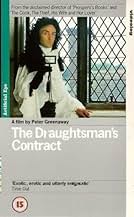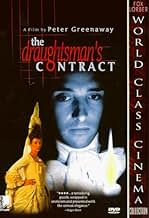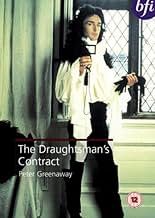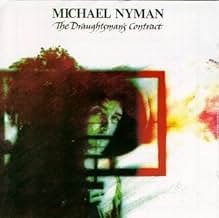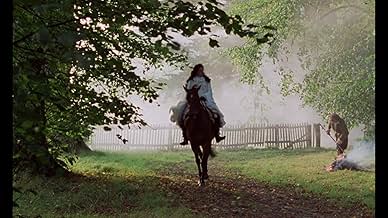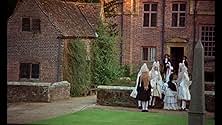NOTE IMDb
7,2/10
12 k
MA NOTE
Un jeune artiste est engagé par la femme d'un riche propriétaire terrien pour réaliser une série de dessins du domaine alors que son mari est absent.Un jeune artiste est engagé par la femme d'un riche propriétaire terrien pour réaliser une série de dessins du domaine alors que son mari est absent.Un jeune artiste est engagé par la femme d'un riche propriétaire terrien pour réaliser une série de dessins du domaine alors que son mari est absent.
- Récompenses
- 1 victoire et 4 nominations au total
Anne-Louise Lambert
- Mrs. Talmann
- (as Anne Louise Lambert)
Nicholas Amer
- Mr. Parkes
- (as Nicolas Amer)
Lynda La Plante
- Mrs. Clement
- (as Lynda Marchal)
Alastair G. Cumming
- Philip - Mr. Neville's assistant
- (as Alastair Cummings)
Commentaire à la une
Is Greenaway our most intelligent filmmaker? One of them at least. He is master of lush self-referential allegory. Here this is hung on a mystery masquerading as restoration comedy. Just maintaining the period and manner is quite a feat.
Self-reference. The film is about an artist who creates rich images that include incongruous elements. The arrogance of the artist is balanced by his blindness as to the meaning, the context of what the images reveal. Both the artist and the viewers are confused by the meaning and flummoxed by the events that the meaning triggers. Greenaway clearly means this to extend to himself, his film and the incompleteness of what we the viewers see. The drawings and the drawer's hands are in fact his.
Fantasy-allegory. This is a film richer in symbology than Drowning and Cook, but probably less so than the later `book' movies. Great attention has been spent on recondite supplementary images, including a central painting in the house being itself painted by the draftsman and filmmaker. I viewed it (the whole film) once just for details. The living statue is only the most obvious illogical element, and in fact draws attention away from other smaller visual diversions.
Mystery artifice. The whole environment is one of genteel artifice, hiding cruel mechanics of conspiracy. The cleverness of the construction is that Greenaway and us are full conspirators. No one, not us, him or the characters shown fully understand what is going on. The mystery form has always been a dialog between artist and consumer, a contest to see who can outwit whom. Very clever use of the mystery form here to include us in the artifice by not ever `playing fair.'
Restoration comedy. Past the visual allegory and the fantasy mystery and the self-reference is a restoration comedy which taken straight is hilarious. The statue is from this form.
My only criticisms are minor. This film contains a restrained story, and incidentally all sex takes place offscreen. Why be so conservative in these areas? Also, Lady Herbert required a more powerful actress I think.
Self-reference. The film is about an artist who creates rich images that include incongruous elements. The arrogance of the artist is balanced by his blindness as to the meaning, the context of what the images reveal. Both the artist and the viewers are confused by the meaning and flummoxed by the events that the meaning triggers. Greenaway clearly means this to extend to himself, his film and the incompleteness of what we the viewers see. The drawings and the drawer's hands are in fact his.
Fantasy-allegory. This is a film richer in symbology than Drowning and Cook, but probably less so than the later `book' movies. Great attention has been spent on recondite supplementary images, including a central painting in the house being itself painted by the draftsman and filmmaker. I viewed it (the whole film) once just for details. The living statue is only the most obvious illogical element, and in fact draws attention away from other smaller visual diversions.
Mystery artifice. The whole environment is one of genteel artifice, hiding cruel mechanics of conspiracy. The cleverness of the construction is that Greenaway and us are full conspirators. No one, not us, him or the characters shown fully understand what is going on. The mystery form has always been a dialog between artist and consumer, a contest to see who can outwit whom. Very clever use of the mystery form here to include us in the artifice by not ever `playing fair.'
Restoration comedy. Past the visual allegory and the fantasy mystery and the self-reference is a restoration comedy which taken straight is hilarious. The statue is from this form.
My only criticisms are minor. This film contains a restrained story, and incidentally all sex takes place offscreen. Why be so conservative in these areas? Also, Lady Herbert required a more powerful actress I think.
Histoire
Le saviez-vous
- AnecdotesDirector Peter Greenaway, a former art student, created the sketches that feature in the film. In fact the close-up shots of the draughtsman drawing are of his hands.
- GaffesThe cooing of a collared dove is not a sound that would have fallen on Jacobean ears, as the species was unknown in Britain until 1955.
- Citations
Mr. Neville: You must forgive my curiosity, madam, and open your knees.
- Versions alternativesWhen Peter Greenaway screened the movie at festivals in 1982, it ran a full three hours. Included in this footage is a full and further explained rationale for the moving statue.
Meilleurs choix
Connectez-vous pour évaluer et suivre la liste de favoris afin de recevoir des recommandations personnalisées
- How long is The Draughtsman's Contract?Alimenté par Alexa
Détails
- Date de sortie
- Pays d’origine
- Langues
- Aussi connu sous le nom de
- The Draughtsman's Contract
- Lieux de tournage
- Sociétés de production
- Voir plus de crédits d'entreprise sur IMDbPro
Box-office
- Budget
- 320 000 £GB (estimé)
- Montant brut aux États-Unis et au Canada
- 2 256 246 $US
- Montant brut mondial
- 2 283 233 $US
Contribuer à cette page
Suggérer une modification ou ajouter du contenu manquant

Lacune principale
By what name was Meurtre dans un jardin anglais (1982) officially released in Canada in French?
Répondre















